1976 German Grand Prix race report
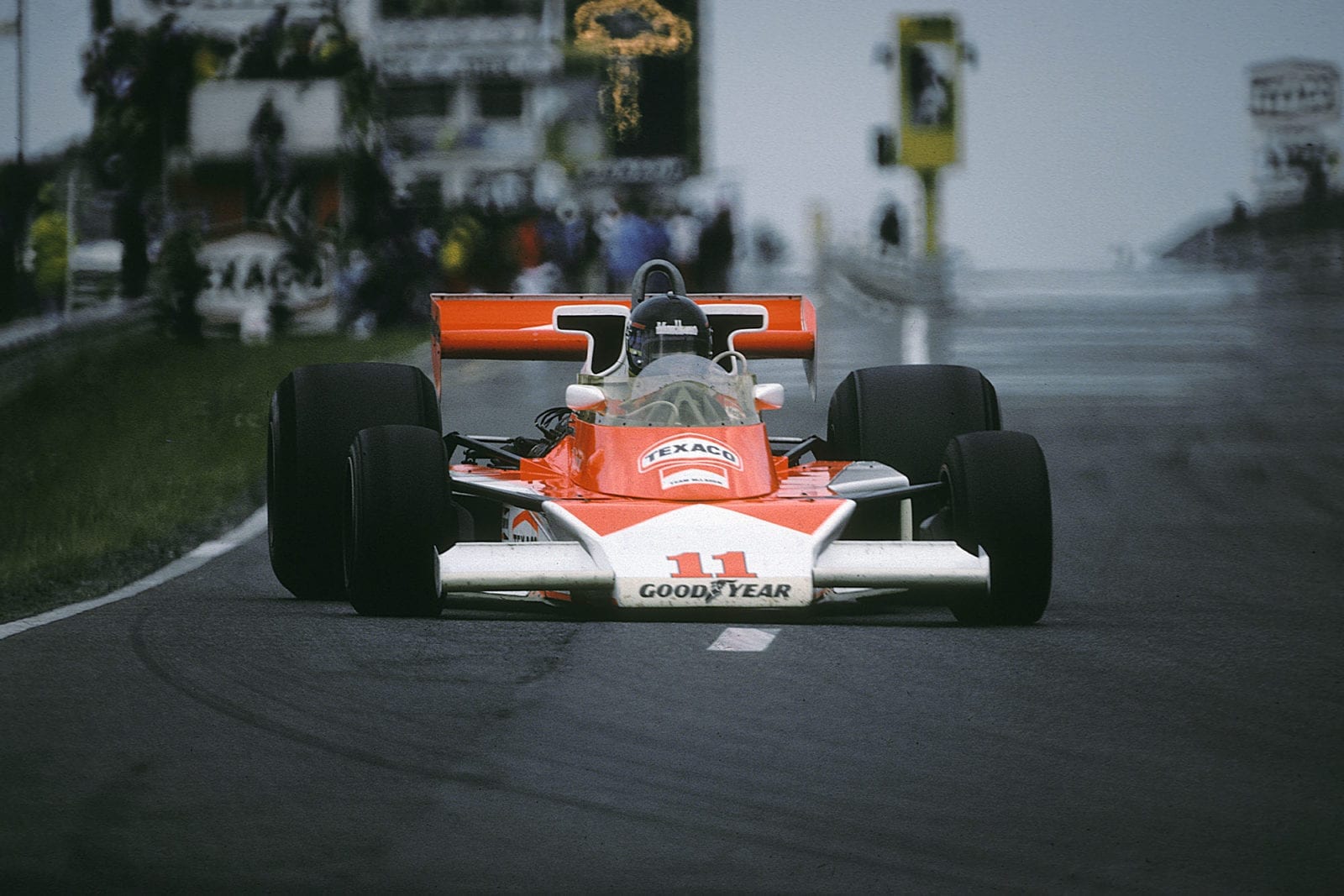
James Hunt took win No 3 for McLaren at the Nürburgring
Motorsport Images
An Englishman wins
Nurburgring, Germany, August 1st
You either love the Nurburgring or you hate it, whether you are a driver or a spectator makes little difference. The Eifel mountains are there for you to enjoy if you want to. You can wonder at the majestic nature of the scenery or the unbelievable task of building the 14.18-mile circuit amid such splendour; you can walk along sections of the track that offer a view in either direction that is more than a complete lap of most circuits. You can hear the cars’ exhausts echoing through the fir forests long before you see them and the sound still travels back long after they arc gone. The Nurbur gring is something very special and always has been. You do not go there to spectate in the same frame of mind as you go to a concrete Stadium, there is space and splendour and almost unlimited viewing possibilities. To hear a Ferrari come up the long, gradual climb from Adenau, to burst into view on the approaches to the Karussell, brake heavily, accelerate round the 180-degree right-hander and storm up the hill to the Karussell itself and then disappear up the hill to Hohe Acht, and over the top, is to appreciate why people visit the Nurburgring in their thousands. That one section of the circuit, if looped round to join the ends together, and transported to England would have everyone raving over a circuit that would be better than Oulton Park, Brands Hatch and Donington Park put together. To see a Grand Prix car burst out of a wooded section as much as two miles away, and watch it come towards you across open country and then disappear over the brow of a hill and hear it on full song downhill until it is gone from earshot is to savour the Nurburgring to the full. If it is a driver who is proud of the title “Grand Prix driver” you will see the art of high-speed driving in action as nowhere else, as he accepts the driving challenge of the Nurburgring. You will not see the close racing as at a Stadium, but you will certainly see Grand Prix driving at its best and of the sort that makes you step back from the fence and whistle through your teeth as you mutter – “me!” The adrenalin flows for driver and spectator alike at the Nurburgring.
Qualifying
For this reason you spend little time in the pits or the paddock, you get in your car and drive round to various vantage points during practice because it is all worth seeing. It doesn’t take long so see which drivers revel in the challenge of the Nurburgring, from National pride like Stuck, Mass and Stommelen, or from acceptance of a real driving challenge like Hunt, Peterson, Pace, Laffite or Regazzoni. The weather in the Eifel mountains can be glorious or gloomy, and the Friday practice sessions of 1 1/2 hours in the morning and an hour in the afternoon were blessed with the Nurburgring being at its best. In spite of professing to be against the Nurburgring and actually leading the group of drivers who are trying to get it banned for Formula One, Niki Lauda rose above personal feelings and did a typical workmanlike job and made fastest lap in the morning, at 7 min. 08.2 sec., a long way off the expected 7 min. barrier. A strong headwind along the final straight made gearing tricky and it doesn’t need much in the way of “losing a little time here” and “a little there” for it to add up to 10 seconds. Last year Lauda recorded the fastest practice lap in 6 min. 58.6 sec., the only driver to break 7 minutes, while Carlos Pace recorded exactly 7 minutes. If Lauda had the same attitude to the Nurburgring as Stuck or Mass, it would be interesting to see how fast he could go. Even so, his average speed was around 120 m.p.h.
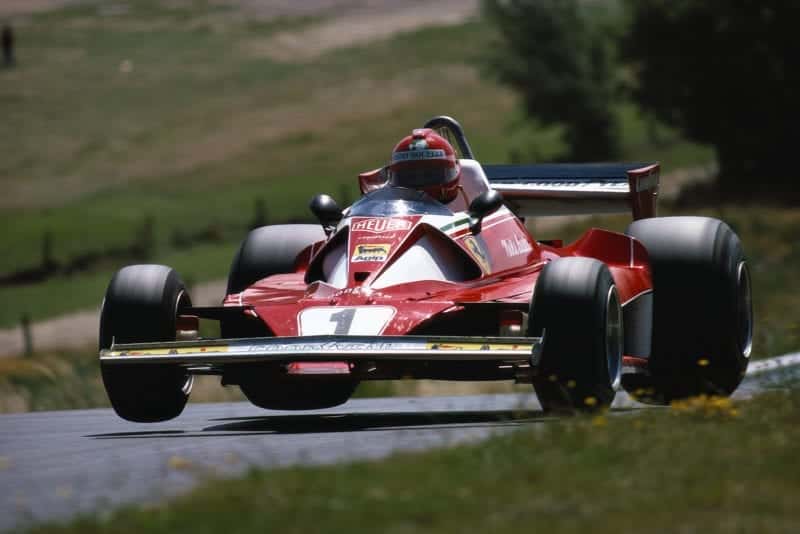
Niki Lauda qualified his Ferrari 2nd
Motorsport Images
During the afternoon session the two Tyrrell six-wheeler drivers got into the swing of things and could be seen to be trying, as was Andretti, but the Italian-American was having to use the spare car as the new one had started to crack around the upper left-hand front engine mounting. This car was using a monocoque fabricated by an outside firm, and the Lotus mechanics were wishing they had made it themselves. Hunt was really trying and looked spectacular, whereas Lauda was nearly as fast with no outward signs of trying hard, except that he was using all the road and the Ferrari engine was working hard, but it was all incredibly neat and tidy. The Brabham Alfas were looking quite good but even so they were six seconds off the pace of the leaders, and it was Hunt who was fastest with 7 minutes 06.5 seconds to Lauda’s 7 minutes 07.4 seconds. Once again those two drivers were in a class of their own, and whether it is on the Nurburgring or at a “Mickey Mouse” Stadium there doesn’t really seem to be anyone who can challenge them.
In the morning session Peterson had had engine trouble before he could set off on a full lap and Pescarolo never left the paddock, his Surtees in trouble with fuel pumps, while Jariers Shadow had a blockage in its fuel system, forcing him to use the spare car. Brambilla flew off the road and damaged the front end of his orange March, so he took Merzario’s old car for the afternoon session, with his own cockpit surround on it, so it was looking a bit odd. The order at the end of the day was Hunt (McLaren), Lauda (Ferrari), Depailler (Tyrrell), Stuck (March), Regazzoni (Ferrari), and Laffite (Ligier). Before the day actually ended the Law arrived in the paddock, representing Loris Kessel who was feeling he had been cheated by John MacDonald’s RAM Racing Team, and the police put a restraining order on the whole RAM set-up and that was the last anyone saw of them. This meant that next morning Stommelen was without a car, which was a waste of good Nurburgring talent, so Mr. Ecclestone offered him the spare Brabham-Alfa Romeo especially as the organisers were very keen to have Stommelen in the race.
Unfortunately Saturday was Nurburgring at its worst, and rain and dark clouds covered everything to begin with, but by mid-morning the rain stopped and the circuit dried remarkably quickly. This was the regulation 1 hours of non-timed practice and quite a lot of drivers set off, even though parts of the circuit were still slippery. Brambilla was back in his orange car, .going incredibly quickly, hut looking as if he was heading for another accident, whereas Stuck looked extremely confident and obviously knew where he was going. Watching on a very fast part of the circuit over near the Karussell Peterson was terrific and made the long walk to the vantage point well worth while. It was pure “vintage” Peterson, but whether he could keep it up for a whole race or whether the March could stand being driven like that was another matter. Stommelen was learning fast about the Brabbant-Al fa. though he knew plenty about the Alfa Romeo part from his sports-car experience, and Pace had an air of seriousness about his driving that suggested he was out to win. The Ferraris looked good, but neither of the McLarens appeared. When it was all over an official car went by with Nilsson’s Lotus on tow, a battery lead having come adrift.
Before the final hour of practice the rain returned which meant that the Friday times were going to decide the starting grid order. Although it stopped raining on parts of the circuit there was no hope of achieving a fast lap time, but even so Peterson did 7 minutes 27.3 seconds, a time that a lot of drivers would have been pleased with on a dry track. As the morning session ended and he was slowing down to return to the pits Brambilla had another accident, this time wrecking the monocoque of his orange March, so it was back into the Merzario car again, for the afternoon session. With it he did 7 minutes 47.5 seconds, the only other driver to get below 8 minutes on the damp track.
Once more there was no sign of the McLarens on the full circuit. Saturday ended in a grey and dismal evening with rain pouring down on the thousands and thousands of tents pitched around the circuit. There were so many spectators that it seemed that if anyone was going to arrive on Sunday morning they would not be able to get in.
Race
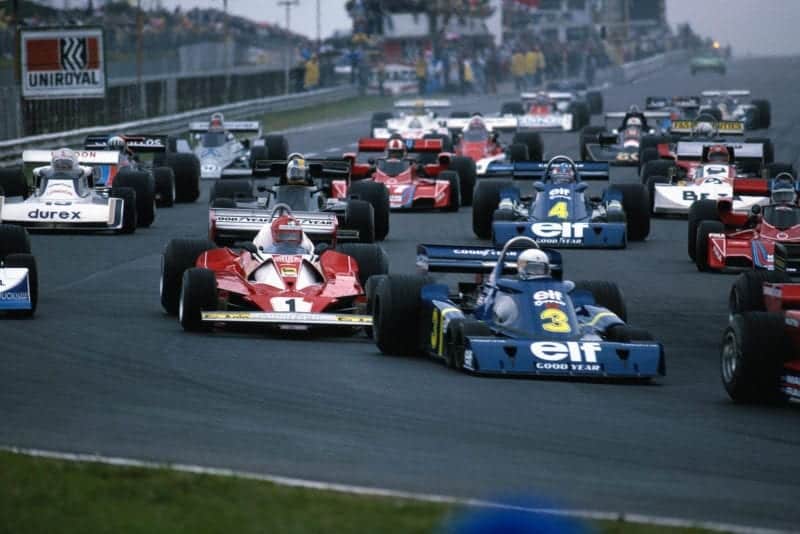
The field crowds into Turn One
Motorsport Images
On Sunday morning there was a 20-minute test-session around the short pits-loop for anyone who wanted a last-minute try-out, though neither the McLaren team nor the Tyrrell team took advantage of it. The rain had gone but the skies still looked unsettled and when the cars began to leave the paddock to drive up through the famous tunnel on to the starting area, it seemed as though all was going to be well, even though a local meteorological office was suggesting there was rain in the offing. Of the 28 drivers who had practised, only 26 were being allowed to start, and of the two non-qualifiers Pescarolo was the most unfortunate as he had got his Surtees going properly when the rain appeared on Saturday. Leila Lombardi had not qualified, but it did not matter as there was no longer a car for her, and no doubt she was demanding her money back from John MacDonald! On a time basis Stommelen had not qualified with the Brabharn-Alfa Romeo, due to the damp conditions on Saturday, hut officialdom agreed to accept that a Brabham was a Brabham, irrespective of engine, so his Friday time was accepted and his place on the grid with BT45/1 was that achieved by BT44B/1.
The 14-lap race was due to start at 1.30 p.m. but a 15-minute delay was announced as there were numerous Renault 5 saloons to sweep up after they had had a race, though it took longer than this. The sky was dull and ominous as the Grand Prix cars set off on a warm-up lap, but there was a hit of a flap when it was realised that the circuit had not been given the “all clear”. Ertl, Scheckter, Depailler, Stuck and Pesenti-Rossi were held at the end of the pit-lane when this was discovered, but all was well and they joined the warm-up lap. At 1.40 p.m. everyone was lined up ready to go when it was announced that rain had started to fall on the far side of the circuit. There was indecision for a few minutes and then people began to change their “slick” tyres for knobbly wet weather ones, as the skies were darkening. A gentle sprinkling of rain in the start area convinced everyone that the rain was going to develop, everyone that is except Jochen Mass and his compatriot Mike Kranefuss of Ford. While Herbert Linge roared off in the official Porsche to do a lap and report on conditions, all the cars except the McLaren of Mass were put onto wet-weather tyres and the Stewards declared the official designation of a “Wet Race”, which meant that rain or shine the race would start and pit-stops for tyre changes if the weather changed were up to the individual team-managers. While most people were worrying about the rule book, Mass and Kranefuss were studying the wind and the clouds and their knowledge of the Eifel Mountains convinced them that the rain was not going to develop any further. The small amount that fell in the start area had already gone and Linge came back with reports of a damp track but no rain. It was now five minutes past 2 p.m. and Mass was taking a gamble that the track would dry, but no-one else was prepared to join him. The two minute warning signal was given and 25 of the 26 engines were started. The odd man out was poor Hans Joachim Stuck; the clutch withdrawal race had seized solid on his March and from his excellent position on the second row of the grid he had to abandon all hope of starting with the rest of the cars. For once Lauda did not make his usual copybook start and it was Hunt and Regazzoni who led down to the first corner, with the Ferrari leading up behind the pits.
Over the Flugplatz: Rcgazzoni was still leading, but then he had the father and mother of a spin on the very fast section down to Aremburg. He did not hit anything and nobody hit him and he gathered it all up and arrived at the lowest point of the circuit in fourth place, behind Hunt, Peterson, and Pace. On that opening lap everyone discovered the circuit to be not as wet as they had expected and Mass was in fifth place as they all started the long straight back to the start area. Hunt (McLaren) was still leading from Peterson (March) and he intended to stop for “dry” tyres, so he eased off and let Peterson go by, hoping the Swede might not realise what was happening. Sure enough, Peterson roared by to finish the opening lap in the lead, while behind him there was an enormous sorting out as some drivers stopped to change tyres and others decided to give it another lap. Hunt, Scheckter, Depailler, Reutemann, Amon, Jarier, Fittipaldi, Laffite, Watson, Pace, Lauda, Merzario, Pesenti-Rossi and Stuck all stopped to change tyres; the last named had joined the race after everyone had gone by driving off in gear on the starter motor, and then changing gear without the clutch.
Peterson, Mass, Regazzoni, Andretti, Nilsson, Pryce, Brambilla, Jones, Stommelen, Ertl, Lunger and Edwards all went by still on their original tyres, but only Mass was sitting pretty. In the Ligier pit there was additional drama. Laffite had come in pointing to the nose of his car for he had tangled with another car in the opening lap and damaged the nose cowling. While the wheels were changed a new nose-cone was fitted, but when the starter was pressed smoke poured from behind the instrument panel. Investigation showed that a contact had been broken by the impact that broke the nose-cowling and there was a dead-short. Wires were cut and taped up and after a long time Laffite got back into the race. Meanwhile Mass had taken the lead from Peterson, a move that was accompanied by a roar from the crowd that nearly shook the Eifel mountains. The tough little German started the third lap well in the lead, his gamble having paid off as the rain had gone for good and the skies were bright. Behind him Peterson dived into the pits for a tyre change, and left again at well over 100 m.p.h. down the pit-lane! Nilsson had gone by in second place, still on “wet” tyres, followed by Hunt, on “dry” tyres, with Pace and Schecktcr following. Andretti, Regazzoni, Jones, Pryce, Brambilla, Stommelen and Depailler were all in the pits and the whole scene was looking most interesting. The McLaren team were pondering the situation that was about to arise, for Nilsson was obviously due to stop, which meant that Mass would be first and Hunt second. If they slowed Mass to let Hunt take the lead and notch up points for the World Championship 250,000 Germans were likely to get violent. If they didn’t they were not being fair to their team-leader. Suddenly the whole scene changed dramatically and tragically.
On the lower part of the circuit after the Adenau Bridge Lauda had crashed violently on a fast left-hand curve. The Ferrari had Spun into the catch fences, ricocheted across the track on fire and was narrowly missed by Guy Edwards in the Hesketh. Lunger was right behind, as was Ertl, and the Surtees and the second Hesketh both hit the Ferrari. The track was blocked and the whole race stopped and then the red flag was shown at the start line to announce the official stopping of the second Grand Prix in succession. While Lauda was taken to Adenau Hospital with facial burns, the crashed cars were gathered up and everyone else returned to the pits, where it was announced that the race would be re-run. Laffite had stopped the Ligier at the scene of the accident and found it would not restart as the wire for the electric pump for the fuel injection had been cut off during the pit-stop and the engine would not start on the mechanical pump alone. Consequently he was towed back to the pits by an official car, at very high speed, but without the engine running the gearbox oil was not circulating and internal damage was being done. As the mechanics pushed the car along the pit lane there was an ominous “clunk” from the transmission as something broke. The organisers were prepared to let Laffite use the spare Ligier for the restart, but one of their “friendly rivals” protested so the French mechanics set to and tore the gearbox apart. Shortly after 3 p.m. it was announced that the race would restart in 10 minutes, with everyone on their original grid positions, with gaps being left for Lauda’s Ferrari, Lunger’s Surtees and Ertl’s Hesketh. Tanks were refilled, new tyres fitted and Lotus did some “continuous development” to Andretti’s car, adding an extra pop-rivet to the front end of the left-hand radiator cover.
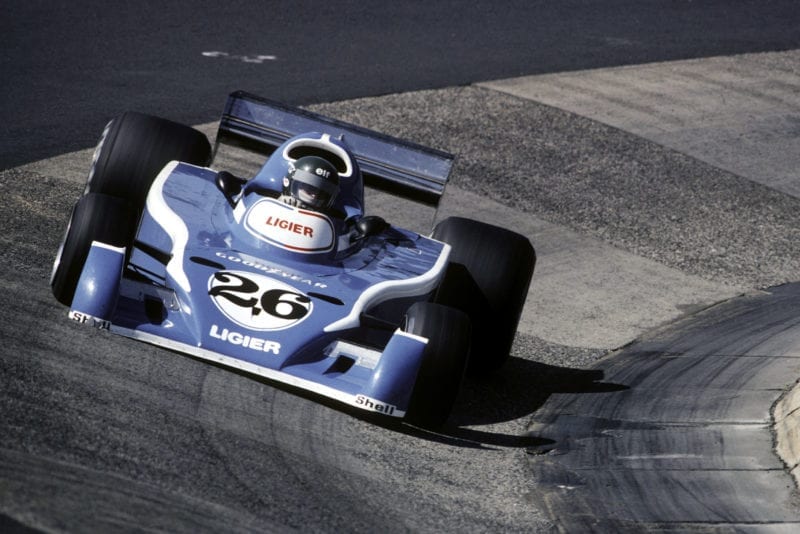
Jacques Laffite could not convert his 6th on the grid into points
Motorsport Images
Without any hysterics Chris Amon quietly announced that he would not be taking the restart with the Ensign. He had lost the taste for driving on the Nurburgring after Lauda’s accident. There should have been 23 cars at the restart, but only 20 did the warm-up lap round the pits-loop, for in addition to the Ensign not leaving the pits the Ligier was still being worked on and as Stuck’s clutch withdrawal mechanism could not be freed, his March was wheeled to the restart, and put to one side of the grid ready to start off in gear on the starter motor after everyone had gone. Hunt was alone on the front row of the grid and shot off into the lead with the 19 survivors following him. Peterson only got as far as the Flugplatz, where he did it all wrong over the brow of the hill and had an almighty accident. The March was reduced to scrap and the Swede stepped out completely unhurt. Reutemann had already come to rest with the toothed belt that drives the fuel injection unit broken, and further round the opening lap there was a lot more excitement. Regazzoni did it all wrong again, getting all sideways without hitting anything, but Depailler struck a back wheel of the Ferrari as it finished swooping about. While the Swiss motored on, in fourth place, the Frenchman bounced off into the scenery fuming. Not far away Andretti and Mass had got into a wheel-bumping situation as they jostled each other side-by-side and eventually Mass spun while Andretti got all crossed up and Scheckter went by them, having been watching the whole episode, only to narrowly miss Regazzoni.
When the turmoil of the second opening lap had subsided Hunt (McLaren) was well in the lead from Pace (Brabham), Scheckter (Tyrrell), Regazzoni (Ferrari), Nilsson (Lotus), Brambilla (March), Andretti (Lotus), Jones (Surtees), Mass (McLaren), Pryce (Shadow) and the rest. Stuck had never got going and the Ligier team had given up their race against time. On the next lap Scheckter moved ahead of Pace, Brambilla had another really good accident wrecking Merzario’s March, and Mass passed Andretti, but as a race the German Grand Prix had fizzled out. For the drivers it had not fizzled out, for when you are driving hard round the Nurburgring the last thing you want to be doing is racing “wheel-to-wheel” and “hub-to-hub” with another competitor. The Nurburgring calls for total concentration by the driver if he is not going to get caught out and Hunt was doing a fine job of work out in front, setting a fastest lap but not a new record lap. Although Hunt had some seven seconds lead over Scheckter at the end of the third lap, with a lap in 7 rninutes 19.8 seconds, the South African responded with a time of 7 minutes 19.1 seconds, showing that Derek Gardner’s six-wheeler was as much at home on the Nurburgring as it had been at Monte Carlo and elsewhere. Regazzoni caught and passed Pace, taking third place, but the talented Brazilian hung on to the Ferrari and the sight of an Alfa Romeo-powered Brabharn matching the speed of a Ferrari caused a lot of embarrassment in parts of the pit lane. Merzario disappeared from the scene with the Williams with reported brake failure on lap 4, and surprisingly that was the last retirement, the remaining fifteen runners keeping going to the end, albeit, some of them relatively slowly and uninspired, relative to Hunt and Scheckter that is.
For lap after lap Regazzoni had Pace and Mass pressing him hard, the performance of the Brabham-Alfa being one of the best we have yet seen. Jochen Mass must have still been feeling a bit “cheated” after the unfortunate stopping of the first race and not a little furious at the result of his bumping match with Andretti in this race. It had not taken him long to deal with Nilsson, but Pace and Regazzoni were a different proposition. These three ran in close company until lap 9 when the Alfa Romeo engine began to splutter out of sharp corners and the McLaren went by and was now sandwiched between the two flat-12 engined cars. On lap 12 (ironical!) Regazzoni made another nonsense and got all crossed up in the Karussell and damaged the nose of the Ferrari and he had to finish the lap slowly and ignominiously while Mass went on in third place with Pace fourth. The Swiss got back to the pits and had a new nose-cone fitted, rejoining the race in ninth place.
Hunt and Scheckter continued to swop fastest laps, the Tyrrell driver getting the final say on the penultimate lap in 7 minutes 10.8 seconds, but they were some 30 seconds apart and even if Scheckter had not been baulked by the incidents on the opening lap it is doubtful if he could have got close enough to worry the McLaren driver. In midfield Andretti had passed his Swedish teammate on lap 6, and from then on Nilson kept nicely in sight of the number one car, doing a very satisfactory job of driving which pleased the Lotus management. They were not so pleased when Andretti came into the pits at the end of lap 10 with the battery broken loose from its mountings. Tape and clips were used to secure it and he was away, but now at the end of the field, with only Pesenti-Rossi and Edwards behind him. Not giving up Andretti hammered on and caught and passed Fittipaldi before the end of the 14 laps.
One of the nicest drives among the lesser lights was that of Rolf Stommelen, with minimal practice with the Brabham-Alfa Romeo and in his first Grand Prix for a long time. He did a best lap of 7 minutes 18.8 seconds, only six-and-a-half seconds slower than the best lap by Pace in the sister car, and his sixth place at the finish was well deserved and more than justified Ecclestone’s loan of the car. Of the others there was not too much to say, the two Shadows ran nonstop from start to finish, but never in the picture, Alan Jones had a spin on the second lap which put him well down the field, from where he never recovered, Fittipaldi was a depressing tail-ender and Pesenti-Rossi did all that was expected of him, as did Guy Edwards. It is interesting that both Shadow drivers took two seconds off their best practice times, during the race. Alan Jones went a mere three-tenths of a second faster in the race, Pesenti-Rossi improved by six seconds and Edwards was four and a half seconds slower. Fittipaldi had been confident that improvements made by Maurice Phinine during practice would show a reduction of at least 15 seconds during the race; the Copersucar-Fittipaldi was actually 2.9 seconds slower! A list of the best lap times by all the finishers is appended making interesting study in conjunction with the starting grid, which gives the best practice time, albeit after only two dry practice sessions.
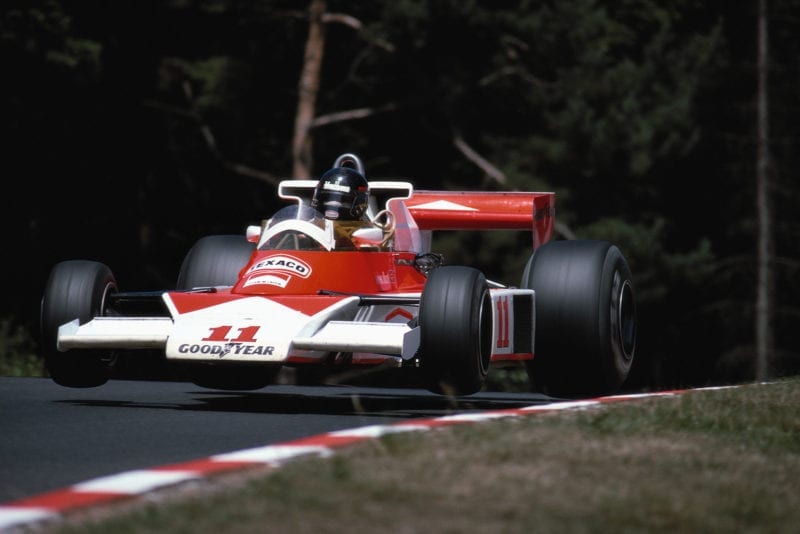
Hunt finished 1st, almost 30sec ahead of his nearest challenger
Motorsport Images
Although Hunt had led from start to finish it was not the way he would have wanted it, with his only serious rival in hospital. When the race was over it was learned that Lauda had been flown to a special burns hospital at Mannheim, which did nothing to alleviate the sad feelings in the paddock. The wreckage of the Ferrari showed that the suggestion that a wheel came off was demonstrably untrue, for while both left-hand wheels and suspensions were detached from the car the wheels were still attached to the uprights and both front and rear showed signs of having been torn off by impact, no doubt by the Surtees and the Hesketh which collided with the stricken car. The left side of the monocoque was split open like a tin of sardines and the fuel cell was gone in its entirety. Ertl had reported seeing this as he hit the Ferrari, the burning fuel cell already separate from the car. The right side of the car was relatively undamaged and the fire damage was not as severe as imagined. The official explanation of the accident was that a link in the rear suspension had broken, which ties in with the fact that the car spun clockwise on a left-hand corner. A driving error would have resulted in an anti-clockwise spin, or an understeer “ploughing” frontal accident. Naturally, everyone was saddened by the accident and the restart was unfortunate but necessary, though had the first race been able to be run the full 14 laps without incident it would have provided one of the most interesting races imaginable.
D.S.J.
